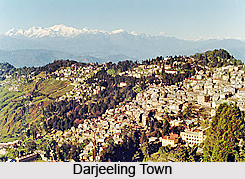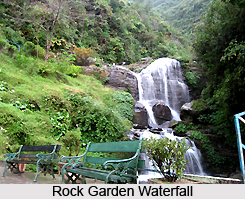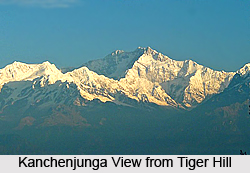 Darjeeling district is situated in the East Indian state of West Bengal and has been crowned with the honour of being the queen of all hill stations in the nation. The plethora of fresh air, scenic beauty and pleasing weather of this district attract thousands of tourists round the year. Numerous tourists and nature lovers` have made the Darjeeling district their second home. Warmth of the local people also makes their stay more exciting and memorable.
Darjeeling district is situated in the East Indian state of West Bengal and has been crowned with the honour of being the queen of all hill stations in the nation. The plethora of fresh air, scenic beauty and pleasing weather of this district attract thousands of tourists round the year. Numerous tourists and nature lovers` have made the Darjeeling district their second home. Warmth of the local people also makes their stay more exciting and memorable.
Location of Darjeeling District
The town and hill station of Darjeeling lies in northern West Bengal, India. The strategic location of Darjeeling is significant and it has become a booming tourist spot. It rises to a height of approximately 7500 feet or 2134 m above the mean sea level. It is the major town of the Sadar subdivision and also the headquarters of Darjeeling district. It is an integral part of the Lower Himalaya as well. Darjeeling district lies between 26 31` and 27° 13` north latitude and between 87° 59` and 88° 53` east longitude. Darjeeling district comprises mainly of mountain terrain and covers an area of around 11.44 sq. kms.
History of Darjeeling District
In 1835, the King of Sikkim gave Darjeeling to the East India Company. It became a popular resort for the British, who wanted to escape from the scorching heat of the plains. The district of Darjeeling has become an iconic name in the context of tea production. Darjeeling produces the world`s most aromatic variety of tea. A mixture of soil, altitude, sunshine, rainfall and the character of the people help Darjeeling produce the most fragrant of teas. It was around 1834 when Lord William Bentinck appointed a committee to consider the factor of importing seeds and plants from China and decided Darjeeling district to be the most favourable localities for growing them. Around 1835 seedlings and tea seeds were distributed to various parts of India, mostly in the hilly regions of the country.
 Other places like Siliguri, Kurseong and Kalimpong are also included in this district. From a small village, Siliguri became a sub-division in Darjeeling district almost a hundred years ago. It was in the year 1907 that Siliguri was declared a sub-division by the British administration. Kalimpong came to prominence after the end of the Anglo-Bhutan War. Since 1959, the year Dalai Lama took shelter in India, a different Kalimpong has developed. Kurseong gets its name from the Nepali word, `Kharshang`, meaning dawn`s pole star. Kurseong which was part of Sikkim was surrendered to the British in 1835 by the king of Sikkim.
Other places like Siliguri, Kurseong and Kalimpong are also included in this district. From a small village, Siliguri became a sub-division in Darjeeling district almost a hundred years ago. It was in the year 1907 that Siliguri was declared a sub-division by the British administration. Kalimpong came to prominence after the end of the Anglo-Bhutan War. Since 1959, the year Dalai Lama took shelter in India, a different Kalimpong has developed. Kurseong gets its name from the Nepali word, `Kharshang`, meaning dawn`s pole star. Kurseong which was part of Sikkim was surrendered to the British in 1835 by the king of Sikkim.
Geography of Darjeeling District
The Darjeeling district has a geographical area of 3,149 sq. kms. It is in an irregular triangle shape. The Northern boundary of the district commences on the west at the peak of Phalut nearly 3657.6 meters high, the meeting point of the boundaries of Nepal and Sikkim. This boundary runs east from Phalut along a ridge descending to the Ramam River. From there, the periphery follows the course of that river until it joins the Rangit and then follows the Rangit until it reaches the Teesta. Proceeding further east, the boundary follows the Tista upstream until its merge with the Rangpochu, from that point it proceeds first up the Rongpochu and then up the Rushattchu, from the Rushattachu, Sikkim and Bhutan boundary are marked as the pillars to the Nechu and to its junction with the Dochu or Jaldhaka.
Summer season starts from May and continues till June. The summer days are soothing and its maximum temperature increases to 25 °C or 77 °F. Heavy rainfall occurs during monsoon season whose duration is June- September. At that time landslips also are common features, which creates blockage of Darjeeling with various places of India. During winter season, the average temperature is 5-7 °C or 41-44 °F. Once in a while temperature drops below freezing point. Mist and fogging are common during monsoon and winter days. Annual mean temperature is 12 °C (53 °F). Monthly mean temperatures, range from 5-17 °C (41-62 °F). Rain wears should be carried throughout the year. During the summer season, light woollens clothes are worn. The pleasant climate of Darjeeling district makes it an ideal destination for holidaying.
Subdivisions of Darjeeling District
Geographically the district can be divided into two particular divisions, the hills and the plains. The entire hilly region of the district comes under Darjeeling Gorkha Autonomous Hill Council, an independent administrative body under the state Government of West Bengal. The council covers the three hill subdivisions of Darjeeling, Kurseong and Kalimpong. The foothills of Darjeeling Himalayas come under the Siliguri subdivision and are also known as Terrain. Siliguri lies at the foot of the hills, which is bounded on the north by the mountains, on the south by the Purnia district of Bihar state, on the east by Jalpaiguri district and on the west by Nepal. Darjeeling district has a length from north to south of 18 miles (29 km), and a breadth from east to west of 16 miles (26 km).

People of Darjeeling District
The original inhabitants of Darjeeling and Sikkim were Lepchas but they constitute a minority of the population in present Darjeeling. In contemporary Darjeeling, Nepali Gurkhas constitute the majority of the population. They hail from different castes and dialect groups like the Gurung, Mangar, Limbu, Tamang, Newar, Rai, Sherpa and Thami communities. The Tibetan community is a comparatively a recent addition to the population of Darjeeling district. Their sect formed when thousands of Tibetan refugees settled across Darjeeling district in 1950 when China captured Tibet. The rest of the population is a blend of people who are from the plains of India like the Bengalis, Biharis and Marwaris.
Culture of Darjeeling District
The culture of Darjeeling is diverse in terms of music, dance, food, festivals and rituals. Music plays a major role in the lives of Darjeeling inhabitants and almost everyone can play a musical instrument. Darjeeling is home to musical stalwarts from Nepali singers such as Gopal Yonzon, Aruna Lama, and Amber Gurung to Louis Banks, the `Godfather of Indian jazz` and Prashant Tamang, the winner of Indian Idol 2007. Traditional dances of Darjeeling include the chutkay dance, jhaure dance, maruni dance and Tamang selos, which have originated in Nepal. Other forms of dance in Darjeeling include the Tibetan Chaam performed with sophisticated costumes and colorful masks during the eve of Losar, the Tibetan New Year.
The culture of this district is closely related to traditional food varieties. The most popular food of Darjeeling is the momo. Momos are either steamed or fried dumplings stuffed either with pork, beef or vegetables and served with a spicy chili and tomato paste along with soup. Thukpa is a noodle dish with meat and/or vegetables in soup that is also a popular dish of the region. Apart from these dishes, the restaurants in Darjeeling offer a wide range of traditional Indian, continental and Chinese cuisines to cater to different palates. Tea is the most popular beverage and a visit to Darjeeling cannot be complete without tasting chhang, the local millet beer.
Religion of Darjeeling District
Hinduism, Buddhism and Christianity are the main religions practiced by people of Darjeeling. In Darjeeling, one can find inter-faith places of worship like the Mahakal Temple, the Hindu temple at Dhirdham or the various Tibetan Buddhist monasteries like Yolmowa Buddhist Monastery, Bhutia Busty Monastery, Yiga Choling Monastery or Ghoom Monastery and the Dali Monastery. Darjeeling also counts the Japanese Peace Pagoda as one of its major religious spots. The town also has many churches built during the British era.
Tourism of Darjeeling District
 Darjeeling in India offers unlimited places of tourist interest. The tourists prefer to visit the magnificent Ghoom monastery on the very first day. This monastery lies 6 km away from the main town. The hillock features the famous Yiga Choeling Monastery which has 15 images of the Maitreya Buddha. Belonging to the yellow hat sect, the monastery contains many antique palm leaf and paper manuscripts in Tibetan script. The Museum of Natural History is where one can see a fine collection of Himalayan animals, reptiles, birds and insects. The tourists can also enjoy the flora collection of Darjeeling in the Llyod Botanical Garden, which has a marvellous collection of alpine flora and orchids.
Darjeeling in India offers unlimited places of tourist interest. The tourists prefer to visit the magnificent Ghoom monastery on the very first day. This monastery lies 6 km away from the main town. The hillock features the famous Yiga Choeling Monastery which has 15 images of the Maitreya Buddha. Belonging to the yellow hat sect, the monastery contains many antique palm leaf and paper manuscripts in Tibetan script. The Museum of Natural History is where one can see a fine collection of Himalayan animals, reptiles, birds and insects. The tourists can also enjoy the flora collection of Darjeeling in the Llyod Botanical Garden, which has a marvellous collection of alpine flora and orchids.
Padmaja Naidu Himalayan Zoological Park in Darjeeling is the only center in India for the breeding of the rare snow leopard. The Ussurian tigers and the Himalayan black bear are also among its breeding species. The Himalayan Mountaineering Institute is located beside the zoo, which is established in 1954 by the then Prime Minister, Jawaharlal Nehru, in the period of the conquest of Everest. Tenzing Norgay was its first Director and Advisor till his unfortunate death. A kilometer from the zoo is the Darjeeling-Rangit Valley ropeway. It provides a thrilling ride with splendid views and is considered to be the longest in Asia. If one is looking for souvenirs, then the best retreat is the Tibetan Refugee Self Help Center. It produces excellent Tibetan crafts like carpets, wood and leather work. Established in 1959 after the Dalai Lama and his followers fled Tibet, Darjeeling district is a haven for ethnic Tibetan art and many cottage houses work on these crafts for income.
Darjeeling in India was the first hill region where organized trekking was first conducted during the 1840s. The breathtaking panoramic views of Everest and Kanchenjunga have been fascinating thousands of nature lovers from different parts of the world since then. The most popular of treks in Darjeeling district are in the areas across the Singalila range in Darjeeling, at Maneybhanjang (2134 m), goes to Meghma (2900 m), Toughu (3070 m), Gairibas (2621 m), Sandakphu (3636 m), and Phalut (3600m). The fourth and last day is the return trek to Darjeeling that may be taken along the along the same route or across Ramman, Rimbick and Bijanbari.
Kalimpong, across the River Teesta, open up to an unexpected panorama. The first sight to greet the eye is the steeple of the Mac Farlane Church; however there are also many more tourist attractions in this picturesque place of the district. Mirik is set in idyllic surroundings and is the ideal place for seekers of peace and tranquility. At an altitude of 1967 meters, the climate of Mirik is cool and temperate. The Sumendu Lake at the bottom of Mirik Spur is the most fascinating feature reflecting the splendour of the eastern Himalayas. The lake is 1.2 kilometers long and is fed by the perennial streams. Riding on the colourful boats or crossing the lake over a beautiful bridge, leads one to a charming path through forests on the other side. Fishing is a popular past time in Mirik.
 Education in Darjeeling District
Education in Darjeeling District
Education in Darjeeling has a strong foundation since ages. Darjeeling`s schools are either run by the state government or by private and religious organisations. The medium of communication used in schools are mainly English and Nepali, although the national language Hindi and the official state language Bengali are also given much importance. The schools are either allied with the ICSE, the CBSE, or the West Bengal Board of Secondary Education. Having been a summer retreat for the British in India, Darjeeling soon became the ideal place of choice for the establishment of public schools, allowing the children of British officials to obtain an exclusive education. Institutions such as St. Joseph`s College (School Dept.), Loreto Convent, St. Paul`s School and Mount Hermon School attract students from all over India and South Asia. Many schools are more than a hundred years old and still adhere to the traditions from its British and colonial heritage. Darjeeling hosts three colleges St. Joseph`s College, Loreto College, Salesian College and Darjeeling Government College; all affiliated to University of North Bengal in Siliguri. Most of the educational institutes of Darjeeling district are boarding schools and colleges.
Economy of Darjeeling District
Tourism and the tea industry are the two most significant contributors to Darjeeling`s economy. Darjeeling tea is considered to be one of the best of black teas and is widely popular, especially in the UK and the countries comprising the former British Empire. The tea industry has confronted competition in recent years from tea produced in other parts of India as well as other countries like Nepal. Several tea estates are being run on a workers` cooperative model, while others are being planned for transformation into tourist resorts. More than 60% of workers in the tea gardens are women. The compensation of workers are usually half in cash and half in other benefits like accommodation, free medical benefits, rations and so on.
The continual growth of population has harmfully affected Darjeeling district`s forests and other natural wealth. The post-independence era has seen extensive advancement in the spheres of education, communication and agriculture. The agricultural scenario includes the production of diverse cash crops like potato, cardamom, ginger, and oranges.
 Farming on terraced slopes is the prime source of livelihood for the rural people around the town and it supplies the town with fruits and vegetables. Darjeeling is a popular filming destination for Bollywood and Bengali cinema; films such as Aradhana, Main Hoon Na and Kanchenjunga have been filmed here. Summer and spring seasons are most popular with tourists, thus fetching the majority of district`s income. Many residents work in hotel and restaurants. Many people also earn a living working for tourism companies and as guides. Small contributions to the economy come from the sale of traditional arts and crafts of Sikkim and Tibet.
Farming on terraced slopes is the prime source of livelihood for the rural people around the town and it supplies the town with fruits and vegetables. Darjeeling is a popular filming destination for Bollywood and Bengali cinema; films such as Aradhana, Main Hoon Na and Kanchenjunga have been filmed here. Summer and spring seasons are most popular with tourists, thus fetching the majority of district`s income. Many residents work in hotel and restaurants. Many people also earn a living working for tourism companies and as guides. Small contributions to the economy come from the sale of traditional arts and crafts of Sikkim and Tibet.
Darjeeling district is famous for its beautiful hill stations, Darjeeling tea and its aroma. Kalimpong, Kurseong and Siliguri are the three other major towns in the district, besides the proper Darjeeling town. The entire district is a marvelous destination for holidaying round the year.



















